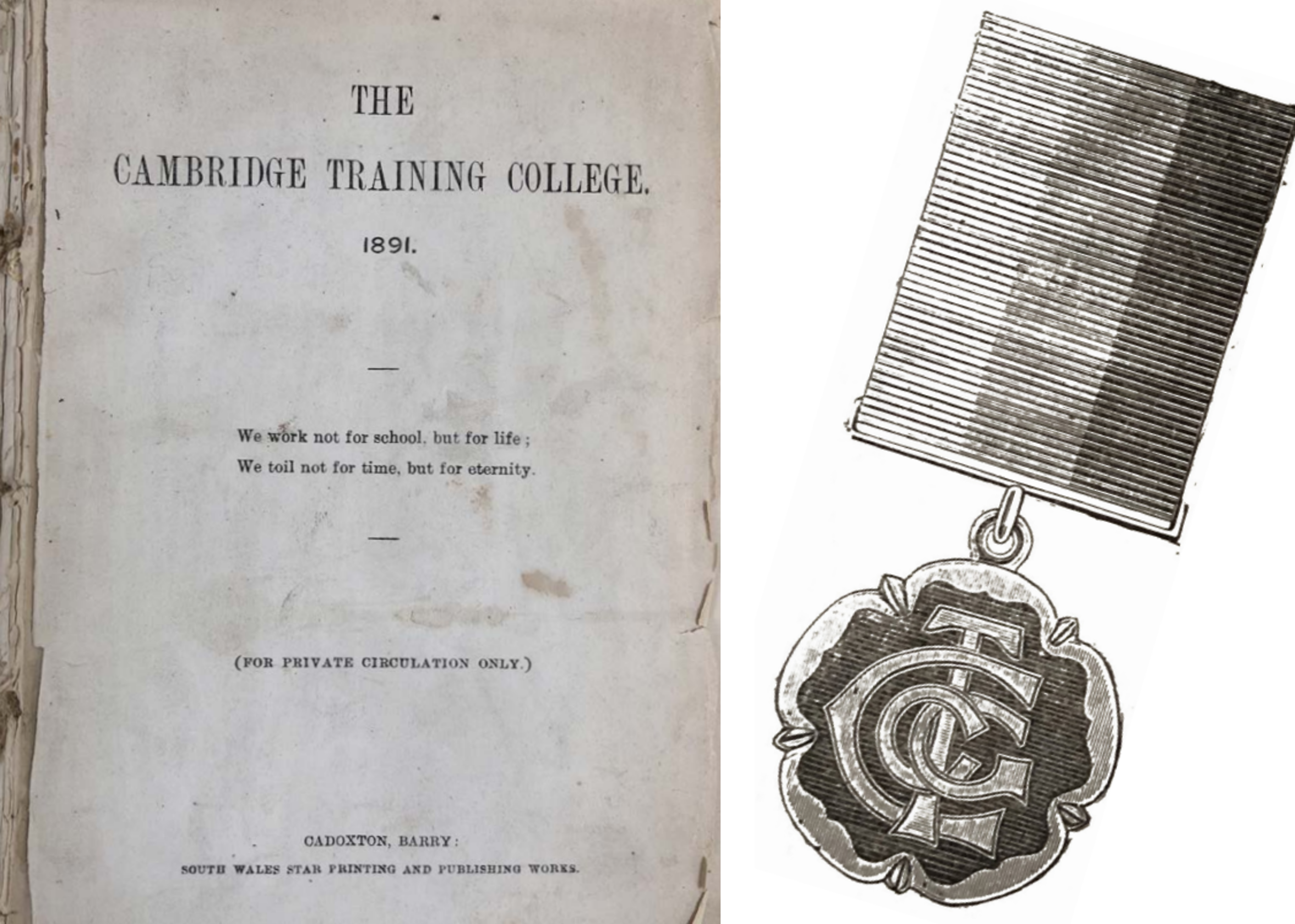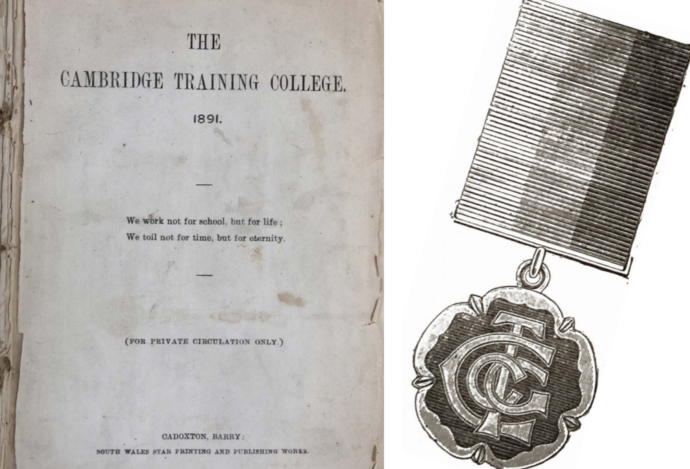Jean Lambert, Life Fellow and former Honorary Archivist of Hughes Hall, writes about the college’s history of mutual aid and supporting its alumnae from its earliest days.
This article was originally published in the Hughes Magazine and is shared again to mark 138 years since the inauguration of the College at its founding Committee Meeting at 3 Newnham Terrace in Cambridge on 9th May 1885.
In 1891, six years on from the foundation of the college, a group of former students, the Principal (Miss Hughes) and her academic colleagues set up The Cambridge Training College Gild (CTC Gild). Their aim was to establish and maintain a close connection with the college’s growing numbers of alumnae, by then some 146 scattered across the UK and various countries in several continents – Australia, South Africa, India and Canada. It was, however, no ordinary alumnae association.
As was typical of the Hughesian pioneering spirit, the association created a special means to extend ‘that union and hearty co-operation’ engendered within the college to a community. It united past and present members, staff as well as students. According to Miss Hughes, this new corporate ‘force’ would enhance the strength and effectiveness of the college – a college the like of which had never been started before, a college in advance of most in the educational world of Cambridge.
Miss Hughes believed: ‘We sow for a distant harvest’. Her vision of the ideal college was one having work to do in the world, both directly by affecting the world and indirectly by benefiting its students. Essentially, it lives for a wider end, for humanity at large.

The title page of the very first Gild Leaflet, published termly between 1891 and 1972; and The Cambridge Training College Gild Badge, designed by Miss Maude Berry. The ribbon was blue, green and yellow, the college colours at the time.
What to call this newly formed organisation? Names suggested include: St Katherine of Siena; Kingcup League; Granta; Camus; Cyfeillach (friendship); and Marsh Marigold – the college flower and, later, the name chosen by the Tramp Club. Gild, Miss Hughes’s preference, held sway. Alternatively spelt ‘guild’, the term has had a contentious history. Although it has been used to refer to any association requiring subscription payments, some historians have restricted its application to the medieval religious fraternities from which many of the livery companies developed. Nevertheless, many historians have adopted it as a generic term for craft and trade organisations, a use that has become ubiquitous. In adopting it, CTC’s gild members acknowledged the original meaning of ‘gild’ as an association of those of the same class for the purpose of mutual aid. One member noted that the spelling ‘guild’ was false – not that there is space to consider that here.
The CTC Gild was steered by a committee consisting of Miss Hughes as president, two college officers as vice-presidents, one of them chair, and several alumnae. Annual membership cost 2s 6d (an eighth of a pound sterling). From its inception, the Gild proved an active fellowship, aligning its projects with the college’s objectives: to experiment, to develop and to improve.
Alumnae supporting alumnae
The Gild organised biannual meetings in London and Cambridge, branches in London, Manchester and Liverpool, and leisure pursuits. In addition its alumnae members provided:
- a mentoring facility for trainees
- information on job opportunities at home and abroad
- a ‘Questions and Answers’ section
- guidance on pedagogical theory and practice, including teaching methods across a broad liberal arts and sciences curriculum encompassing health and physical exercise, including some that were experimental or proposed for different types of disability
- funds for a new building (now the Margaret Wileman Building), for study and educational travelling scholarships, in memory of a student that died, for the college loan fund, and to alleviate college debts
- trees for the gardens
- and set up a loan library.
By 1894, to create a visible sign of group affinity, it had also produced the marigold badge (in silver at 10s [one half of a pound sterling] or bronze at 2s 6d). Members wore them at various gatherings, political as well as professional, notably, the Assistant Mistresses Association and the Teachers’ Guild. Sadly, no example of this artefact has, so far, been recovered although we do hold an illustration of the original design.
The Gild Leaflet
Thanks to the Gild Leaflet, published termly between 1891 and 1972, we have systematic records of matriculations and alumnae vocational destinations from 1885 to the association’s demise in 1972 – the year before Hughes Hall admitted students in disciplines besides education. The Leaflet also included information on overseas visitors and Gild, college and student activities.
The pages of the Gild Leaflet preserve many things of value to us historically. Among these are: the principal’s and students’ termly ‘letter’; the Gild and college contributions to the war effort and subsequent ‘Reconstruction’ in the 1914–1918 period; the Sunday evening working men’s meetings in Miss Hughes’s rooms; lectures by prominent figures; an increasing offering of extra-curricular activities, such as overseas school visits – for instance, to China, Russia, South East Asia and Australia; and clubs and societies devised by and engaging students and alumnae throughout the 81 years of the Gild’s existence.
Composing verse, often read at the famous ‘cocoa’, was an abiding student pleasure. Published examples afford us an insight into student concerns, sensibilities and erudition, all often conjoined, as in one poet’s whimsical tour through a ‘medley’ of educational thought.
We can only speculate on the impact of the corporate force of the Gild on Hughes Hall and the world beyond, and on the presence of the past in our collegiate lives. Yet, from what is preserved in the pages of our forerunners’ Leaflet, it can be claimed with certainty that 19th and early 20th-century graduates of this college were in great demand and actively sought by employers, or, to borrow from one alumna, that they had ‘a good passport’. And, undoubtedly, the material evidence around us stands testament to the ‘solid foundations’ of that distant harvest sown by Miss Hughes, her students and a handful of supporters almost 130 years ago.
Originally published in Hughes Magazine, edition 30, Michaelmas Term 2020, available in full here: www.hughes.cam.ac.uk/wp-content/uploads/2021/06/Hughes-Issue-30-Michaelmas-Term-2020.pdf.
10.5.23





